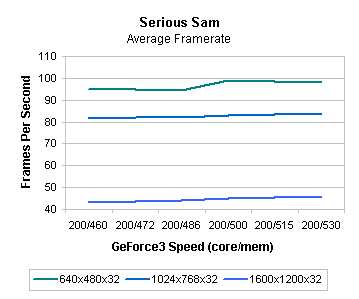NVIDIA GeForce3 Roundup - July 2001
by Matthew Witheiler on July 25, 2001 11:39 PM EST- Posted in
- GPUs
Overclocking the Memory
The previous section proves that the memory bus of the GeForce3 is not holding the card back too much, especially compared to the bottlenecks we have seen in the past. We were still interested to see if increasing the memory clock speed while leaving the core clock untouched would still result in a performance increase.

Once again, the upward slope of the lines indicate that performance did increase as the memory clock was overclocked. Since the card did experience performance increases when the memory clock speed was raised, it does prove that the card is still a bit memory bandwidth bottlenecked even at the shipping clock speed of 200MHz. Ideally, if the GeForce3 experienced no memory bandwidth limitations, performance would not increase at all as the memory clock speed was increased. Since performance increased by 3% at 640x480x32, 3% at 1024x768x32, and 7% at 1600x1200x32, we can say that the GeForce3 still does not have all the memory bandwidth it would like at the shipping 460MHz memory clock speed..
It is not surprising that overclocking the memory provided only incremental gains at 640x480x32 and at 1024x768x32 because at these resolutions the GeForce3 is only slightly memory bandwidth limited. As you can see, performance gains leveled off at these two resolutions at around the 500MHz mark due to the fact that the core is what is limiting the card at these resolutions and high memory speeds.
Nor is it surprising that the largest speed increase came at 1600x1200x32. As we saw when we overclocked the core, performance gains seemed to level off at this high resolution due to memory bandwidth constraints. As the memory clock was increased, effective memory bandwidth increased, thus allowing the card to realize the most gains at the resolution where the most data must be passed: at 1600x1200x32.
As you can see, quite a bit has changed since that last GeForce product we looked into overclocking: the GeForce2 GTS. No longer is core speed unimportant, like the case in the GeForce2 GTS. The GeForce3's Lightspeed Memory Architecture does seem to provide some relief to the crowded memory bus, but does not completely eliminate it as a bottleneck. So, unlike the GeForce2 GTS where only memory clock speed mattered in overclocking, the GeForce3 depends on both a high core and memory clock to perform at the best overclocked ability.
The best way to overclock your GeForce3 is to push both the memory and core speeds as high as they well go, as we did in this review. Moving up the speeds together will provide you with the maximum performance possible.
Now that we know how to overclock the cards, lets take a look and see how our 7 contenders did, not only when overclocked, but also in terms quality, features, and more.










0 Comments
View All Comments